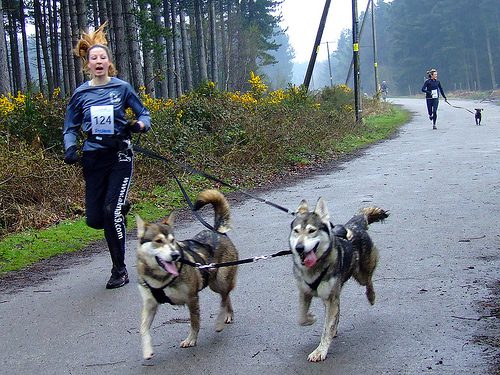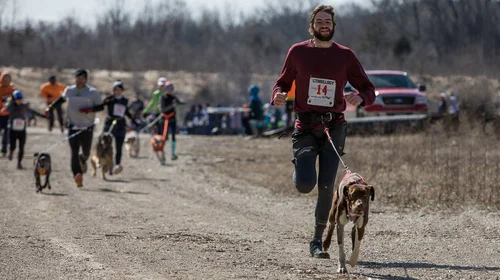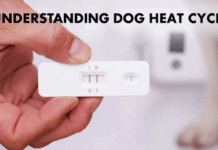Last Updated on January 9, 2024 by Dog Lover
Canicross: Unleash Your Inner Wild (and Your Dog’s Too!)
Imagine this: the wind whips through your hair as you weave through sun-dappled woods, the ground a blur beneath your feet.
Beside you, a furred blur streaks ahead, paws pounding the earth, tongue lolling with joyous abandon.
This isn’t just a run; it’s a primal symphony of shared exhilaration, an exhilarating partnership woven from speed, trust, and the untamed spirit of the trail.
Welcome to the world of Canicross, a sport where you and your canine companion become one, hurtling through nature’s embrace in a joyous dance of paws and feet.
Forget treadmills and gym memberships; Canicross offers a fitness adventure unlike any other.
It’s not about chasing numbers or setting records; it’s about embracing the wind in your face, the mud on your shoes, and the unbridled joy of running free with your best furry friend.
Imagine the thrill of your four-legged partner pulling you along, a living engine of fur and muscle propelling you towards breathtaking vistas and unforgettable moments.
This isn’t just exercise; it’s a deepening bond with your dog, a shared language of trust and exhilaration forged in the crucible of the trail.
But what exactly is Canicross?
Simply put, it’s a sport where you run with your dog attached to you by a special harness and bungee cord.
This cord absorbs the pulls and tugs, ensuring a smooth and comfortable experience for both you and your canine companion.
Whether you’re a seasoned runner or a weekend warrior, Canicross is open to anyone with a willing dog and a thirst for adventure.
Ready to dive into the world of Canicross?
Buckle up, dog lovers, because we’re about to embark on a journey that will have you and your furry friend howling with happiness…

Unleashing the Benefits: Why Canicross is More Than Just a Run
Canicross isn’t just about blazing trails; it’s a treasure trove of physical and mental benefits for both you and your dog.
Let’s unleash the advantages:
For You:
- Cardio King: Imagine a workout that feels like playing fetch in a forest. Canicross is a natural cardio booster, strengthening your heart, lungs, and muscles. Your dog becomes your personal trainer, pushing you further and helping you reach new fitness goals, all while you’re having a blast.
- Stress Slayer: Ditch the meditation app and hit the trail. Canicross is a potent stress reliever. The rhythmic pounding of paws, the fresh air filling your lungs, and the shared joy with your dog are a potent cocktail that washes away worry and leaves you feeling rejuvenated and happy.
- Nature Fix: Forget the stuffy gym; Canicross takes you outdoors, immersing you in the healing power of nature. Breathe in the clean air, soak up the sunshine, and reconnect with the wild spirit that lives within. It’s a natural mood booster and a reminder of the simple joys life has to offer.
For Your Dog:
- Energy Outlet: Does your dog seem like a furry whirlwind trapped in a house? Canicross is the ultimate energy outlet. It allows them to unleash their natural instincts to run and explore, leaving them happy, tired, and content.
- Mental Stimulation: Forget repetitive fetch; Canicross is a mental feast for your dog. The new sights, smells, and challenges of the trail engage their minds, keeping them sharp and happy.
- Bonding Boost: There’s nothing like the shared experience of Canicross to strengthen the bond between you and your dog. The trust, teamwork, and shared joy create a connection that goes beyond words.
But is Canicross right for my dog? Don’t worry, we’ll answer that in the next section…
Gearing Up for the Adventure: Choosing the Right Equipment
Before you hit the trail, it’s essential to have the right gear for both you and your furry friend.
Here’s what you need:
For You:
- Comfortable running shoes with good grip: You’ll be tackling uneven terrain, so invest in footwear that can handle the demands of the trail.
- Running belt or waist harness: This attaches to your dog’s harness and absorbs the pulls, ensuring a smooth and comfortable run for both of you.
- Running gloves: Not essential, but can provide extra grip and protect your hands from unexpected tugs.
For Your Dog:
- Canicross harness: This specially designed harness distributes the pulling force evenly across your dog’s chest and shoulders, preventing injury.
- Bungee cord: This shock absorber protects both you and your dog from sudden pulls and jerks, ensuring a comfortable and injury-free run.
- Booties (optional): If you’re tackling rough terrain or cold weather, consider protective booties for your dog’s paws.
Remember: Proper fit is crucial for both your harness and your dog’s. Consult a knowledgeable shop assistant or veterinarian to ensure the gear is appropriate for your and your dog’s size and build.

Ready to Hit the Trail? Top Tips for Canicross Newbies:
Now that you’re geared up, it’s time to unleash the wild!
But before you bolt out the door, here are some top tips for Canicross beginners:
- Start slow and short: Don’t overwhelm your dog or yourself. Begin with short, walk-run intervals and gradually increase distance and pace as your fitness and teamwork improve.
- Choose the right terrain: Start on flat, smooth trails until you both get comfortable. Avoid rocks, roots, and obstacles that could cause injury.
- Warm up and cool down: Just like any workout, proper warm-up and cool-down are essential for both you and your dog. This prevents injuries and ensures peak performance.
- Listen to your dog: Pay attention to your dog’s body language. If they’re panting excessively, lagging behind, or showing signs of distress, take a break or call it a day.
- Make it fun!: Above all, Canicross should be a joyful experience for both of you. Keep it fun, positive, and full of praise. Remember, it’s about shared adventure, not competitive sprints.
Beyond the Basics: Exploring the World of Canicross
As you and your dog gain confidence, the world of Canicross opens up. You can:
- Join a Canicross club: Training with other Canicross enthusiasts can be a great way to learn, improve, and make new friends (both human and canine!).
- Participate in races: Once you’re ready, test your skills and teamwork at Canicross races. It’s a fun and exhilarating way to push your limits and celebrate your bond.
- Explore new trails: The world is your oyster! Take your Canicross adventures to new landscapes, from mountain trails to beach runs.
Canicross: More Than Just a Sport, It’s a Transformation
Canicross is more than just a sport; it’s a transformation.
It’s about rediscovering the joy of movement, the thrill of connection, and the magic of shared adventure.
It’s about connecting with your dog on a deeper level, forging a bond built on trust, mutual respect, and the shared language of the wild.
So, why not unleash your inner wild (and your dog’s too!) and join the Canicross revolution?
The trail awaits, and the wind whispers promises of unforgettable adventures.
Ready to take the first step? Let’s answer some frequently asked questions.

FAQs
What breeds are best for Canicross?
While medium to large breeds with high energy levels and strong pulling power like Huskies, Retrievers, and German Shepherds are often preferred, any healthy and fit dog can participate in Canicross with proper training and conditioning. Consult your veterinarian to ensure your dog is ready for the physical demands of the sport.
How old does my dog need to be to start Canicross?
Wait until your dog is fully grown and their bones and joints are mature, typically around 12-18 months depending on breed size. Start with short, gentle runs and gradually increase duration and intensity.
Can I train my dog for Canicross myself?
Absolutely! There are plenty of online resources and training guides available. However, consider consulting a professional Canicross trainer, especially if you’re new to the sport, to ensure proper technique and prevent injuries.
Is Canicross safe for my dog?
With proper training, conditioning, and equipment, Canicross is a safe and enriching activity for most dogs. Always listen to your dog’s body language and prioritize their well-being throughout the run.
Where can I find Canicross events and communities?
Online resources like Facebook groups, regional running clubs, and dedicated Canicross websites can connect you with local events, training opportunities, and fellow enthusiasts.
So, what are you waiting for?
Grab your leash, lace up your shoes, and embark on the exhilarating journey of Canicross.
Remember, it’s not just about the miles you run; it’s about the memories you create, the bond you strengthen, and the wild spirit you unleash, together.
Remember, Canicross is a journey, not a race.
Savor the feeling of the wind in your hair, the rhythmic pounding of paws beside you, and the unspoken language of shared joy that connects you and your furry friend in a way no treadmill or gym ever could.
So, go forth, unleash your inner wild, and let the trails become your canvas for a shared adventure like no other.
The world awaits, and the spirit of Canicross beckons.
So, there you have it, dog lovers! Take the first step towards an adventure unlike any other.
Lace up your shoes, grab your leash, and embrace the spirit of Canicross.
Remember, it’s not about achieving records; it’s about creating memories, strengthening bonds, and unleashing the wild spirit that resides within both you and your furry friend.
The trail awaits, and the wind whispers promises of unforgettable adventures. Happy Canicrossing!
Verified Source References for Canicross Article:
- General Benefits of Canicross:
- Physical & Mental Health Benefits:
- http://fondation-apsommer.org/doc/wp-content/uploads/sites/7/2018/05/425.pdf
- https://newsnetwork.mayoclinic.org/discussion/the-health-benefits-of-pets/
- https://www.thsdaily.com/new-york-health-news/rochester-health-alert-another-surprising-benefit-of-pet-ownership-doctor-explains/article_cd440256-a992-11ee-a11a-db77ab19ff0c.html
- Choosing the Right Equipment:
- Training Tips for Beginners:
- Additional Resources:

















